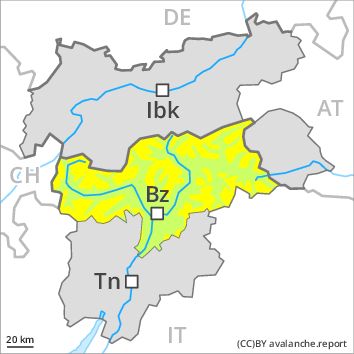Regions
Sexten Dolomites, Eastern Pfunderer Mountains, Durreck Range, Western Rieserferner Mountains, Val Müstair Alps, Western Deferegger Alps, Langtaufers, Ortler Range, Schnals Ridge, Southern Stubai Alps, Ulten Valley, Southern Zillertal Alps and High Tauern, Eastern Nonsberger Alps, Northern Dolomites of Fiemme, Saldurn-Mastaun Ridge, Gröden Dolomites, Texel Mountains, Prags Dolomites, Sarntal Alps, Western Pfunderer Mountains

Danger level
Avalanche Problem
Persistent weak layer above 2200m, N-NE-E-NW
Wind-drifted snow above the treeline, N-NE-E-SE-S-SW-W-NW

Wind slabs above the tree line. Fresh wind slabs are to be avoided.
The fresh wind slabs are to be avoided above approximately 2000 m. Single backcountry tourers can release avalanches in some places. Mostly they are rather small. The older wind slabs can still be released. Caution is to be exercised at their margins in particular. Avalanches can be released in the old snowpack and reach large size in isolated cases. This applies in particular adjacent to ridgelines.
Snowpack
The snowpack will be subject to considerable local variations over a wide area. In some cases the wind slabs have bonded still only poorly with each other and the old snowpack. They are to be found in particular adjacent to ridgelines and in gullies and bowls and at high altitudes. In little used backcountry terrain the avalanche situation is a little more dangerous.
Tendency
The avalanche danger will persist. The weather will be mostly sunny.